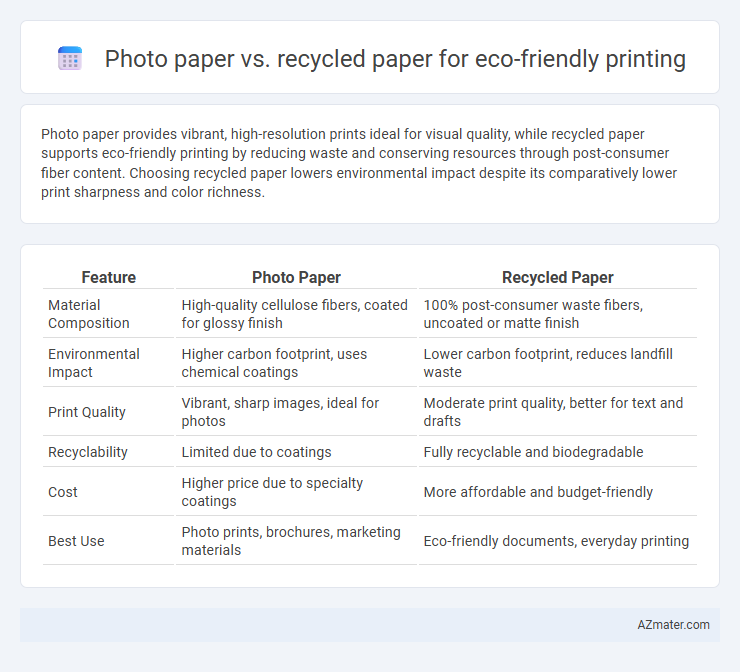Photo paper provides vibrant, high-resolution prints ideal for visual quality, while recycled paper supports eco-friendly printing by reducing waste and conserving resources through post-consumer fiber content. Choosing recycled paper lowers environmental impact despite its comparatively lower print sharpness and color richness.
Table of Comparison
| Feature | Photo Paper | Recycled Paper |
|---|---|---|
| Material Composition | High-quality cellulose fibers, coated for glossy finish | 100% post-consumer waste fibers, uncoated or matte finish |
| Environmental Impact | Higher carbon footprint, uses chemical coatings | Lower carbon footprint, reduces landfill waste |
| Print Quality | Vibrant, sharp images, ideal for photos | Moderate print quality, better for text and drafts |
| Recyclability | Limited due to coatings | Fully recyclable and biodegradable |
| Cost | Higher price due to specialty coatings | More affordable and budget-friendly |
| Best Use | Photo prints, brochures, marketing materials | Eco-friendly documents, everyday printing |
Introduction to Eco-Friendly Printing
Eco-friendly printing prioritizes sustainable materials like photo paper and recycled paper to minimize environmental impact. Photo paper, known for its glossy finish and high image quality, often contains chemical coatings that can hinder biodegradability. Recycled paper, produced from post-consumer waste, significantly reduces deforestation and energy consumption, making it a greener choice for environmentally conscious printing.
Understanding Photo Paper: Composition and Uses
Photo paper is coated with a light-sensitive emulsion, typically containing silver halide crystals or inkjet-compatible polymers, designed to produce high-resolution, vibrant images with sharp detail and glossy or matte finishes. It is predominantly used for photographic prints, art reproductions, and professional marketing materials requiring superior color accuracy and durability. The dense coating and specialized surface texture enhance ink absorption and image longevity, making photo paper ideal for eco-friendly printing when paired with sustainable inks and responsible disposal practices.
What is Recycled Paper? Types and Benefits
Recycled paper is made from recovered paper fibers, reducing the need for virgin pulp and minimizing environmental impact. Common types include post-consumer recycled paper and post-industrial recycled paper, both offering sustainable alternatives for printing needs. Benefits of recycled paper include conserving natural resources, lowering energy consumption, and reducing landfill waste, making it a preferred choice for eco-friendly printing over photo paper.
Environmental Impact: Photo Paper vs. Recycled Paper
Recycled paper significantly reduces environmental impact by lowering deforestation rates and energy consumption compared to photo paper, which typically uses virgin fibers and chemical coatings that hinder biodegradability. Photo paper's production involves chemical treatments and plastic layers that increase landfill persistence and pollution, while recycled paper supports circular resource use and decreases greenhouse gas emissions. Choosing recycled paper for eco-friendly printing promotes sustainable forestry and minimizes waste, making it a greener alternative to traditional photo paper.
Print Quality Comparison: Photo Paper vs. Recycled Paper
Photo paper delivers superior print quality with vibrant colors and sharp details, making it ideal for high-resolution images and professional photo prints. Recycled paper typically presents a more textured surface and muted tones, which may result in less crisp and vivid prints but offers an eco-conscious choice for everyday printing needs. Choosing between photo paper and recycled paper depends on balancing print excellence with environmental impact, emphasizing the importance of sustainable materials in eco-friendly printing.
Cost Analysis: Is Recycled Paper More Affordable?
Recycled paper generally offers a more affordable option compared to photo paper, with prices often 20-40% lower per ream depending on quality and sourcing. Photo paper, designed for high-resolution image printing, demands higher production costs due to specialized coatings and materials, leading to a premium price point. For eco-friendly printing projects focused on budget efficiency, recycled paper balances cost savings with environmental benefits while maintaining acceptable print quality for most standard documents.
Ink Absorption and Longevity: Which Paper Performs Better?
Photo paper offers superior ink absorption due to its specially coated surface, ensuring vibrant colors and sharp details while minimizing ink smudging. Recycled paper typically has lower ink absorption capacity, causing colors to appear dull and sometimes leading to ink bleed, but it significantly reduces environmental impact through the reuse of materials. For longevity, photo paper resists fading and maintains print quality over time, whereas recycled paper often degrades faster under exposure to light and moisture, making photo paper the better choice for durable, high-quality eco-friendly printing when balancing ink performance and print lifespan.
Recycling Challenges: Photo Paper vs. Recycled Paper
Photo paper poses significant recycling challenges due to its glossy coatings and chemical treatments that complicate fiber recovery and processing. Recycled paper, in contrast, is specifically processed for easier re-pulping and fiber reuse, leading to greater efficiency in recycling systems and reduced environmental impact. Choosing recycled paper for eco-friendly printing minimizes landfill waste and conserves resources by supporting closed-loop recycling practices.
Best Practices for Sustainable Printing
Photo paper typically uses glossy, non-recyclable materials that hinder composting and increase landfill waste, while recycled paper minimizes environmental impact by reducing deforestation and conserving water. Selecting recycled paper with post-consumer content supports circular economy practices and lowers carbon footprints in printing. Incorporating soy-based inks or vegetable dyes further enhances eco-friendly printing by enabling easier paper recycling and reducing toxic chemical emissions.
Choosing the Right Paper for Your Eco-Friendly Printing Needs
Photo paper offers vibrant color quality and sharp image reproduction, ideal for high-resolution prints, but it often contains coatings that can hinder recyclability. Recycled paper reduces environmental impact by utilizing post-consumer fibers, lowering deforestation and energy consumption while maintaining acceptable print quality for everyday documents. Selecting the right paper involves balancing print quality needs with sustainability goals, favoring recycled paper for general use and photo paper only when image clarity is paramount.

Infographic: Photo paper vs Recycled paper for Eco-friendly printing
 azmater.com
azmater.com